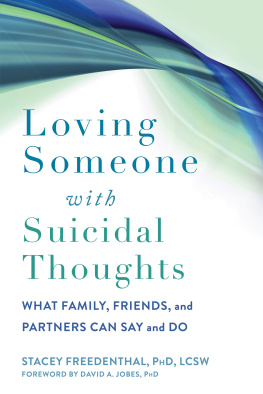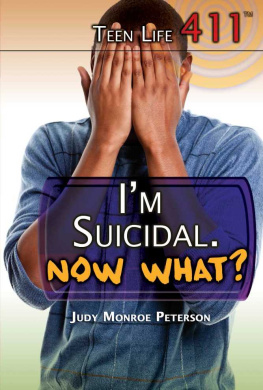
SUICIDE
PREVENTION
TECHNIQUES
HOW A
SUICIDE CRISIS SERVICE
SAVES LIVES
JOY HIBBINS

Jessica Kingsley Publishers
London and Philadelphia
CONTENTS
INTRODUCTION TO THE AUTHOR
Joys tireless dedication to providing safe, supportive and therapeutic help for people thinking about suicide has led to the Suicide Crisis Centre and numerous presentations, blogs and newsletters that reach and inform people from all sectors. Her thoughtful assimilation of personal experience, experience of those who use her service, evidence and policy, and opinions of others in the field is informative and stimulating. Joys work is rooted in her values of collaboration and she has developed strong and productive relationships with the clients she serves and with healthcare providers and other agencies involved in the suicide prevention endeavour. It has been a privilege to get to know and to learn from Joy and I look forward to adding to my knowledge and understanding by reading her book.
Karen Lascelles
Nurse Consultant Suicide Prevention,
Oxford Health NHS Foundation Trust
CHAPTER 1
LIVED EXPERIENCE
HOW IT IMPACTS ON OUR SERVICES
If I had not experienced suicidal crisis myself, I would not have gained the knowledge and understanding which allowed me to set up a service which was not only innovative, but which truly met the needs of our clients.
In March 2012, a deeply traumatic experience changed my life. During the experience I felt shock, horror and fear. Within hours of the event, I started to experience flashbacks and intrusive thoughts: symptoms of post-traumatic stress disorder (PTSD). The symptoms became overwhelming. Memories of the event returned uninvited. I could neither process what had happened to me, nor escape from the memories of it. As the days passed, I started to have suicidal thoughts. This was the beginning of a suicidal crisis that led to community mental health crisis support, and, ultimately, psychiatric hospital admission.
I had not experienced psychiatric services prior to 2012. Initially, an on-call doctor referred me to the crisis team, otherwise known as the crisis resolution and home treatment team.
The crisis team is a community psychiatric team which provides home visits to people under their care. They usually visit every day when the person is in crisis. The service was set up as an alternative to psychiatric hospital.
I struggled to engage with the team. A different crisis team member would come out to see me every day. The usual practice was for eight or more team members to be involved. They would visit on rotation. With a huge caseload and limited time, they rarely had the opportunity to read up more than the previous days notes about me. This meant that some of them did not know what had triggered my crisis. As a result, I had to repeat traumatic information again and again to different team members, which meant that I was reliving the event multiple times and re-experiencing the horror of it.
When you have experienced something traumatic, your ability to trust people may evaporate. In the period after such a trauma, it can be difficult enough to build up trust with one person, let alone a whole team. This made connecting with the crisis team challenging for me. The team recognised this and tried to limit the number who visited me, but shifts and staff shortages made that impossible.
Additionally, when multiple team members are involved, it can lead to a lack of continuity of care.
The clinical distance of psychiatric staff proved challenging for me. I understand why such distance exists, and I will explore that later in the book. However, it left me equally detached and disengaged.
On one occasion, a crisis team member arrived at my home, came into the dining room and took one of the chairs away from the table in order to sit at the far end of the room, at the furthest possible distance from me. It was an act which served as a powerful symbol of the gulf between us.
One of the effects of a traumatic event is that it can subsequently lead to a need to feel in control. During the traumatic experience, you may have been rendered powerless, and may have felt a total loss of control over what was happening. That is a feeling that you may never wish to replicate. However, as a patient under psychiatric services you can often feel that the power is removed from you, and that it lies with the psychiatric service and its clinicians. There is a significant power imbalance between psychiatrist and patient. Additionally, the community psychiatric teams (such as the crisis team) decided how often the team would see me and the kind of treatments and care I would receive. They also decided when to discharge me. Significantly, I still felt at risk of suicide at the point when I was discharged.
At the same time (apart from when I was detained under the Mental Health Act (passed in 1983) or sectioned), I was told directly that it was my choice or my decision to end my life. This was a profoundly unhelpful message, which I felt validated the decision to die. It was clearly not the intention of the clinicians that their words should be interpreted in this way.
It seemed as though I had total freedom of choice over whether to live or die but no choice about the kind of psychiatric care I received, or the services I could access. These were just some of the aspects of psychiatric care which made engagement difficult for me. It became clear to me that there was a need for a different kind of crisis care one which would involve using different techniques and strategies from those of the crisis team. We would also interact and communicate with clients in an entirely different way. Furthermore, we would alter the power balance between professional and client, empowering and giving autonomy to the client but actively intervening to keep them safe when they were in crisis, whether or not they had the mental capacity to make decisions. Our focus would be on working tenaciously to help them stay alive throughout the time that they were under our services.
Instead of maintaining clinical distance, we would openly care for our clients, recognising the power of kindness and care in reaching a person at the point of suicide. We would demonstrate that caring for clients is not incompatible with a professional relationship which has clear boundaries. We would find ways to reach people who were off the radar of other services; people who other services were describing as hard to reach. We would engage people who were described as difficult to engage.
Having identified that there were sometimes gaps in the current mental health system through which people could fall, we would seek to eradicate them, creating a safety net around our clients which would keep them safe. Importantly, we would respond to a crisis wherever it occurred. Throughout all this, the lived experience perspective would remain at the heart of our work.
Ultimately, it was not just my own experience of suicidal crisis which influenced the way we work at the Suicide Crisis Centre. It was also the experiences of our first few clients, who helped shape the services we now provide. In assessing their individual needs, it became clear that we would have to adapt our services, and provide additional ones, to ensure that we met their needs and to ensure that they survived.
My lived experience has an enduring impact on my work. Although formal training has been vital, my own experience has given me a depth and breadth of knowledge which I draw upon regularly. It also gives me a profound empathy with our clients experiences, and a deep understanding of what it is like to be in crisis.
Next page














